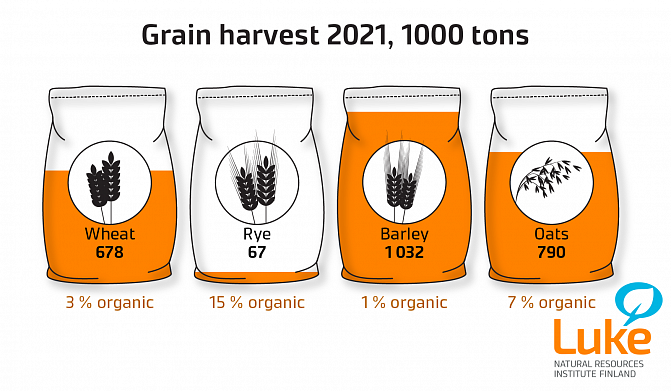The 2021 cereal harvest was scarce – the lowest barley and oat yields in decades
The 2021 cereal harvest totalled 2.6 million tons. The barley harvest was one third lower than average, while the oat harvest was a quarter lower and the rye and wheat harvests a fifth lower than average. The last time the barley harvest was this low was in the 1970s and the oat harvest in the 1980s.
Farms were hoping for higher harvest levels, as only three years ago in 2018 Finland’s cereal harvest was as low as in the previous year.
“In Southwest Finland, known as Finland’s breadbasket, drought particularly reduced the cereal harvest. Harvests from Ostrobothnia to the north were nearly at the average level,” says Anneli Partala, senior statistician at the Natural Resources Institute Finland (Luke).

Already a shortage of barley
The barley harvest was barely higher than one million tons. As the domestic consumption of barley – mainly as feed and malt – normally totals 1.4 million tons, there is already a shortage of barley. The scarcity of the most important fodder cereal presents difficulties to livestock farms that are forced to buy expensive cereals. On certain farms, this scarcity, combined with other difficulties, may also lead to production reductions or discontinued operations.
The oat harvest was less than 800,000 tons. Oat is an important fodder cereal alongside barley. Oats have increasingly been used as food and, at least so far, there have been enough oats for the Finnish food industry. The low rye harvest of less than 70,000 tons does not cover our annual consumption of roughly 100,000 tons. As the previous year’s harvest was nearly identical, we may be forced to import rye before the next autumn’s harvest.
The wheat harvest of less than 700,000 tons covers our annual consumption. Wheat is the most popular cereal consumed as food. The domestic consumption of wheat as food at more than 200,000 tons is more than double compared to rye. More wheat is consumed as feed than as food – more than 300,000 tons a year in recent years.
The smallest potato harvest in six years
At 560,000 tons, the potato harvest was a tenth lower than in the previous year. It was the ninth lowest potato harvest in Finland’s 100-year statistical history. Domestic potato stock levels have still been sufficient for grocery stores, while they are the lowest in ten years. The last time potato stock levels were this low was at the beginning of 2013, following the third lowest potato harvest in statistical history at roughly 490,000 tons.
The pea area higher than the potato area – drought reduced yields
Pea farms also suffered from last summer’s drought, with the pea harvest being a fifth lower than in the previous year. However, the pea harvest was still the second highest in statistical history, as pea farming took a leap forward two years ago. In 2020, the pea area was higher than the potato area for the first time. The outlook for pea farming is promising for the next few years, as Finland is aiming to increase its self-sufficiency in proteins, for which pea farming offers opportunities alongside broad bean farming.
The organic oat harvest fell by a third
Oat is the most important organic cereal in Finland, and its production was nearly 60,000 tons. The organic oat harvest decreased by 30 per cent from the previous year. On the other hand, the organic rye harvest increased slightly from the previous year to roughly 10 million kilos. As a result, organic rye already accounted for 15 per cent of Finland’s total rye harvest. Organic oats accounted for seven per cent of the total oat harvest.
Several years of low harvest levels, combined with increased costs and general uncertainty over profitability, cause concern among many Finnish farmers. Solutions are being sought to the sector’s difficulties, and they will have an impact on the next growing season’s farming decisions.
Background to the statistics
Luke collected crop production information from approximately 6,100 farms, of which 730 were organic farms, using telephone interviews and an online survey. The harvest statistics consist of information obtained from approximately 5,400 farms. Information about the quality of the cereal harvest has been compiled by combining the crop production information collected by Luke and the Finnish Food Authority’s cereal quality monitoring information.
All information is available in the stat.luke.fi service. The service includes crop production information about key crops in all parts of Finland starting from 1920, and organic information starting from 2006. Regional crop production information is available in the service starting from 1999, and organic information starting from 2014. Conventionally produced crop production information is available in the service starting from 2020.
Tables related to the harvest statistics are available on the home pages of the statistics.
You
can subscribe to Luke’s statistics via email.

